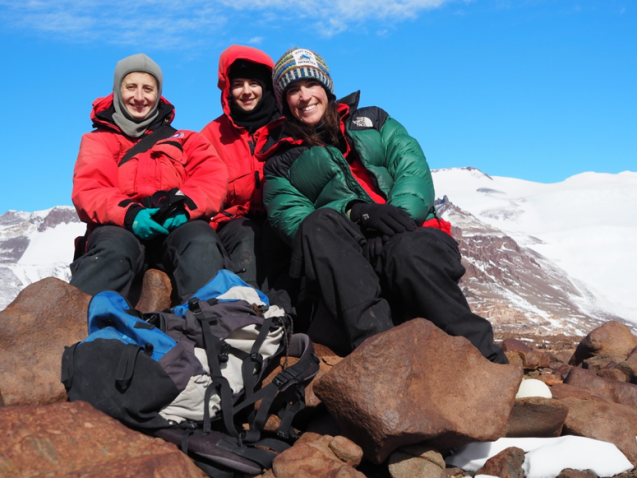Celebrating the International Day of Women and Girls in Science
Women scientists play an essential role in the Earth Institute’s mission to understand how the planet works, how humans are changing it, and how to build a sustainable future.

The United Nations has designated February 11 as the International Day of Women and Girls in Science. The day is meant to promote gender equality in science, technology, engineering and mathematics. Despite recent progress, the UN says that long-standing biases and gender stereotypes are steering girls and women away from science-related fields. Women and girls continue to be excluded from participating fully in science, and remain underrepresented in these fields.
At the Earth Institute at Columbia University, women scientists play an essential role in the work we do to understand how the planet works, how humans are changing it, and how to build a sustainable future. State of the Planet makes it a priority to highlight these achievements every day, week, month, and year. Although it would be impossible to call out every woman-led research project in one single blog post, here’s a small selection of our recent posts featuring the important work of women researchers within the Earth Institute.
- Disease ecologist Maria del Pilar Fernandez explains her work tracking down communities in Argentina that are at high risk for Chagas disease. This insect-borne disease causes swelling, fever, diarrhea, and vomiting, and in some cases heart failure and cardiac arrest.
- At a time when it seems like the world falling apart from violence and hate, Allegra Chen-Carrel and her colleagues study places that are peaceful, to understand what peace looks like, feels like, and how it is achieved and sustained. In a recent blog post, she describes what she and her colleagues have been learning from the African island nation of Mauritius.
- Elisabeth Ilboudo-Nébié studies the links between land degradation and human migration in Burkina Faso. Understanding what drives migration can help governments to better manage the process and prepare support systems for influxes of people.
- While disasters don’t discriminate against people when they strike, the most vulnerable groups of society bear the brunt of the burdens during the aftermath of disasters. Jaishree Beedasy studies those impacts and how to facilitate disaster recovery.
- New research led by atmospheric scientist Mingfang Ting reveals that climate change has triggered two changes that threaten crop production in the U.S.’s Corn Belt. This region grows a third of the global supply of corn.
- Large parts of the world were cast into darkness around 536 A.D. In Europe and Asia, the sun only shone for about 4 hours a day, and accounts say it gave no more light than the moon. Recent findings from Dallas Abbott and her colleagues are helping to solve the mystery behind this extreme sky-darkening.

- Architecture and urban planning students have been working with the residents of Vieques, Puerto Rico, to design resilient solutions that could help the small island recover after Hurricane Maria. The collaboration would not have been possible without the efforts of Maria-Paola Sutto and Vilma Rivera Gallagher.
- Using old tree rings and archival documents, historians and climate scientists have detailed an extreme cold period in Scotland in the 1690s that killed as much as 15 percent of the population. A recent study led by Rosanne D’Arrigo indicates that political isolation likely worsened the situation — an important cautionary tale as the U.K. plans to leave the European Union.
- Radhika Iyengar is one of the leads on a project that is testing wells in India and warning communities about wells that have high fluoride contamination. Long-term ingestion of large amounts of fluoride can lead to dental problems, joint problems, and abdominal pain and vomiting.
- Beth Tellman is developing new ways to assess how well remote sensing algorithms identify flooding. Her work could help to enable better flood protection.
- Despite decades of relative peace and recent efforts to promote gender equality, women and girls in Mozambique continue to experience a disproportionate amount of insecurity. A report partially authored by the Women, Peace and Security Program at Columbia University reveals the importance of having an inclusive vision of peace and security that fully accounts for issues of everyday human security and wellbeing, like gender-based violence.
- Planetary systems scientist Linda Sohl studies ancient climate processes, the conditions that may have influenced life’s evolution on Earth, and what all that might imply for the emergence of life on other worlds. In an interview with State of the Planet, she explains how she reconstructs climate models to aid the search for alien life.
- Landscape designer Kate Orff is working with the city of Johnstown, Pennsylvania, to show how climate adaptation could help to revitalize the nation’s so-called “Rust Belt.”
There are, of course, hundreds more women-led research projects happening throughout the Earth Institute, and State of the Planet will continue to cover as many as possible. You can use this form to suggest ideas.
The Earth Institute is committed to promoting a culture and work environment that is diverse, equitable, inclusive, safe and welcoming of all. Read about some of our initiatives here and here.
